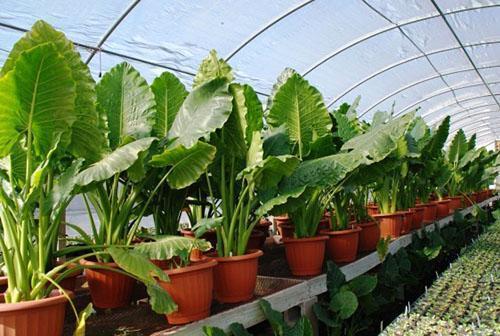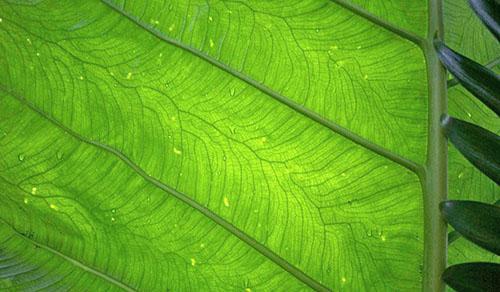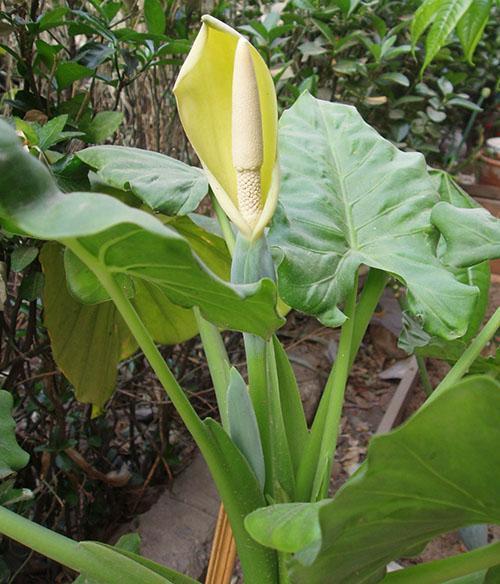Home care for large-root alocasia
 Rainforests are famous for their diversity of flora, and thanks to the abundance of moisture and nutrients, plants here can reach truly enormous sizes. Large-root alocasia, which lives in humid regions of Australia and Oceania, as well as in other regions of southern and southeast Asia, is no exception.
Rainforests are famous for their diversity of flora, and thanks to the abundance of moisture and nutrients, plants here can reach truly enormous sizes. Large-root alocasia, which lives in humid regions of Australia and Oceania, as well as in other regions of southern and southeast Asia, is no exception.
Features and characteristics of large-root alocasia

Therefore, a florist caring for large-root alocasia at home may not know about all its features. However, some nuances should alert and raise reasonable questions. For example, the leaves used by the local population as green umbrellas can themselves be a source of rainfall.
If the plant receives too much moisture, the excess water pumped by the roots and stems is removed from the leaf plates through the stomata.
 In the wild, this phenomenon often goes unnoticed. It's a different matter if the culture is planted in an apartment. According to popular opinion, alocasia in this way is able to "predict" the weather. But botanists do not observe this ability in a plant. But seeing drops of water on large-root alocasia, the florist must conclude that watering is excessive and make adjustments to the care of the plant.
In the wild, this phenomenon often goes unnoticed. It's a different matter if the culture is planted in an apartment. According to popular opinion, alocasia in this way is able to "predict" the weather. But botanists do not observe this ability in a plant. But seeing drops of water on large-root alocasia, the florist must conclude that watering is excessive and make adjustments to the care of the plant.
 Another surprise that the large-rooted alocasia presents is the appearance of large inflorescences. Like other representatives of aroids, from tiny, nondescript flowers, alocasia forms an inflorescence-cob with a white or greenish bracts. In appearance, the alocasia flower shown in the photo looks like inflorescences spathiphyllum and callas, but much larger than them.
Another surprise that the large-rooted alocasia presents is the appearance of large inflorescences. Like other representatives of aroids, from tiny, nondescript flowers, alocasia forms an inflorescence-cob with a white or greenish bracts. In appearance, the alocasia flower shown in the photo looks like inflorescences spathiphyllum and callas, but much larger than them.
After pollination, the perianth dies off, and rounded red fruits form in place of the flowers. They are not edible, but thickened rhizomes, which are actually underground stems, and succulent leaf petioles among the local peoples of Oceania and Melanesia, after long heat treatment, are used in their daily diet.
If you try a raw stem, burning, astringent due to the presence of calcium oxalate, a person will clearly not like the taste. But for pets, the juicy greens of alocasia are a welcome food.
So, how to care for large-root alocasia at home? What conditions are required for a tropical dweller? And is it true that the plant has a healing effect?
Home care for large-root alocasia
 If a large-root alocasia appears in an apartment, its owner will not have to pay too much attention to the new tenant, but forget that the plant is a native of the tropics. First of all, a comfortable atmosphere is important for alocasia, therefore the air in the room:
If a large-root alocasia appears in an apartment, its owner will not have to pay too much attention to the new tenant, but forget that the plant is a native of the tropics. First of all, a comfortable atmosphere is important for alocasia, therefore the air in the room:
- in summer should be warmed up to 22-28 ° C;
- in winter it cannot get colder than 18–20 ° C.
All alocasia, including the large-rooted variety, do not like drafts, so the plants are placed away from balcony doors and transoms.A rainforest dweller, alocasia thrives best in partial shade. At the same time, young plants react more sharply to adults both to direct sunlight and to a lack of lighting in the winter months.
Variegated varieties that have become popular today are more in need of light than plants with even green leaves.
If caring for large-root alocasia at home does not meet the needs of the culture, you will not be able to get beautiful contrasting foliage. In the shade, even white areas gradually turn green.
 No less than the air temperature, its humidity is also important. In nature, the plant is constantly in a warm, humid climate. Therefore, getting into home conditions, large-root alocasia can seriously suffer from excessively dry air. In the summer, especially on hot days, alocasia must be irrigated with warm, settled water. In winter, when spraying, you should be very careful, since carrying out such a procedure in cool air is fraught with the development of fungal and putrefactive diseases.
No less than the air temperature, its humidity is also important. In nature, the plant is constantly in a warm, humid climate. Therefore, getting into home conditions, large-root alocasia can seriously suffer from excessively dry air. In the summer, especially on hot days, alocasia must be irrigated with warm, settled water. In winter, when spraying, you should be very careful, since carrying out such a procedure in cool air is fraught with the development of fungal and putrefactive diseases.
It is much safer to wipe the leaf plates with a damp cloth, which will improve the appearance of the plant and also make it easier to breathe. When caring for large-rooted alocasia at home, do not use chemicals that prevent dust from settling.
Alocasia is hygrophilous and very demanding on watering... Plants react extremely sharply to lack of moisture, irregular or scanty watering. A large volume of green mass requires a lot of water and nutrients. And if alocasia experiences discomfort, the leaves wither and may even fall off. But even with excessive watering, especially in winter, you should not expect the plant to feel good.
Drops of water on large-rooted alocasia are a signal of a small overflow.
If the plant is poured systemically, the earthen lump constantly retains a large amount of moisture, the alocasia reacts by the appearance of yellow and then brown spots on the leaf plates, loss of foliage and decay of the root system.
 In the summer, alocasia is watered often and abundantly, making sure that between waterings the top layer of the soil dries out noticeably. 30-40 minutes after the soil is moistened, all excess water must be drained. On hot days, it is reasonable to put a pot of alocasia in a tray filled with water, into which expanded clay or crushed stone is previously poured. So, the roots of the plant will not come into contact with the moist environment, but the soil will not dry out either. In winter, alocasia is slightly limited in moisture, watering 2-3 times a week.
In the summer, alocasia is watered often and abundantly, making sure that between waterings the top layer of the soil dries out noticeably. 30-40 minutes after the soil is moistened, all excess water must be drained. On hot days, it is reasonable to put a pot of alocasia in a tray filled with water, into which expanded clay or crushed stone is previously poured. So, the roots of the plant will not come into contact with the moist environment, but the soil will not dry out either. In winter, alocasia is slightly limited in moisture, watering 2-3 times a week.
It is in winter that it is very important to monitor the state of the foliage - an indicator of the health of this culture. Watering the plants is reduced as soon as drops of water become visible on the large-rooted alocasia. If the leaves are covered with spots, we can already talk about a disease of the plant or the presence of rot on its underground part.
To maintain a large plant, alocasia must be fed. It is best to apply fertilizers during the period from early spring to mid-autumn. The composition of fertilizers for tropical crops includes both organic and mineral supplements... If desired, these components can be alternated.
The reason for the slow development of alocasia, wilting of foliage and rotting of underground stems and roots can be an incorrectly selected composition of the soil mixture.
 The indigenous inhabitant of the tropics requires a loose, nutrient-rich soil with a neutral or slightly acidic reaction. In a pot intended for large-root alocasia, a good drainage layer is required. And as a soil, a mixture of:
The indigenous inhabitant of the tropics requires a loose, nutrient-rich soil with a neutral or slightly acidic reaction. In a pot intended for large-root alocasia, a good drainage layer is required. And as a soil, a mixture of:
- 2 parts of humus;
- 1 part sand;
- 1 part peat;
- 2 pieces of garden land.
To retain moisture, the soil surface can be mulched with fine pebbles, sand or wood chips.
 Plants are transplanted in the spring, transferring the alocasia together with the soil lump into a more spacious pot.
Plants are transplanted in the spring, transferring the alocasia together with the soil lump into a more spacious pot.
It is important to remember that by planting a culture in a very spacious container, you can provoke the growth of alocasia. And here you need to consider the possibility of placing a grown plant in the room.
Adult bushes require transplanting no more than 3-4 years later, and young alocasia can be transferred to a new container annually. The procedure is carried out in the spring, when the plants acclimatize faster and easier.
At home, large-root alocasia is propagated by vegetative methods by dividing an adult plant, by layering or cuttings. And in this case, spring is also the best time. In order for the seedling to take root and quickly acquire a good root system, it needs a temperature of at least 20-22 ° C. It is better to root alocasia in a light mixture of equal proportions of peat and sand. When the cuttings give roots, they are transplanted into the soil for mature plants.
 Alocasia is unpretentious and grows without any problems even among gardeners with little experience. If caring for large-root alocasia at home is insufficient, the plant is affected by both diseases and pests. Juicy greens attract many dangerous insects. Most often, spider mites, mushroom gnats, scale insects, aphids and mealybugs can be found on large petioles and leaves.
Alocasia is unpretentious and grows without any problems even among gardeners with little experience. If caring for large-root alocasia at home is insufficient, the plant is affected by both diseases and pests. Juicy greens attract many dangerous insects. Most often, spider mites, mushroom gnats, scale insects, aphids and mealybugs can be found on large petioles and leaves.
When identifying pests, you cannot hesitate. The plant must be treated with insecticides, which are selected depending on the type of insect found. When alocasia is affected by fungi, fungicides are used in the fight against them.
The owner of large-root alocasia, caring for a plant at home, needs to remember the toxicity of its juice and do not forget about safety measures. In homes where there are children and pets, alocasia is placed out of their reach.
The healing properties of large-root alocasia
 Many flower growers, planting large-root alocasia in an apartment, in addition to the appearance of the plant, are also fascinated by the abundance of its medicinal properties. Indeed, at home - in the countries of Oceania, southern Asia and other regions, where today alocasia grows in nature, it is revered by traditional medicine.
Many flower growers, planting large-root alocasia in an apartment, in addition to the appearance of the plant, are also fascinated by the abundance of its medicinal properties. Indeed, at home - in the countries of Oceania, southern Asia and other regions, where today alocasia grows in nature, it is revered by traditional medicine.
The burning, and sometimes very caustic sap of the plant is used as a distracting, local irritant for joint diseases. On its basis, as well as crushed stems, ointments, decoctions and alcoholic infusions, gruels and oils are made.
The medicinal properties of large-root alocasia are in demand not only for joint diseases, osteochondrosis and rheumatism, but also:
- with bruises, accompanied by bruising;
- with thrombophlebitis and varicose veins;
- in the presence of thyroid diseases;
- with hemorrhoids
- with gout and arthritis;
- with a number of tumor diseases;
- with weakened immunity and frequent infectious diseases
 For the preparation of a natural medicine, thickened stems and roots of alocasia are taken. In Borneo, where the nutritional and medicinal properties of large-root alocasia are most respected, the plants are harvested in large quantities, in the rest of the world - this exotic culture has been little studied.
For the preparation of a natural medicine, thickened stems and roots of alocasia are taken. In Borneo, where the nutritional and medicinal properties of large-root alocasia are most respected, the plants are harvested in large quantities, in the rest of the world - this exotic culture has been little studied.
Wanting to use the properties of large-root alocasia in the treatment of a particular disease, one must remember that the plant is toxic and can bring not only relief, but also serious harm to health.
In European medicine, due to the lack of scientific research, there is no scientific confirmation of the plant's healing properties yet. The technique of internal and external use of such drugs has not been developed either. Therefore, in order to avoid undesirable consequences, one cannot do without consulting a specialist.